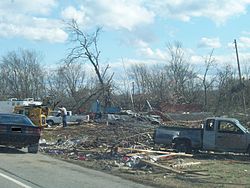Castalian Springs, Tennessee
Castalian Springs, Tennessee | |
|---|---|
 Post office, destroyed by a tornado, in Castalian Springs, Tennessee, 2008 | |
 Castalian Springs, Tennessee | |
| Coordinates: 36°23′37″N 86°18′29″W / 36.39361°N 86.30806°WCoordinates: 36°23′37″N 86°18′29″W / 36.39361°N 86.30806°W | |
| Country | United States |
| State | Tennessee |
| County | Sumner |
| Settled | 1780s |
| Named for | The Castalian Spring of ancient Greece |
| Area | |
| • Total | 5.817 sq mi (15.07 km2) |
| • Land | 5.817 sq mi (15.07 km2) |
| • Water | 0 sq mi (0 km2) |
| Elevation | 495 ft (151 m) |
| Population | |
| • Total | 556 |
| • Density | 96/sq mi (37/km2) |
| Time zone | UTC-6 (Central (CST)) |
| • Summer (DST) | UTC-5 (CDT) |
| Area code(s) | 615 |
| GNIS feature ID | 1305723[3] |
Castalian Springs is an unincorporated community and census-designated place (CDP) in Sumner County, Tennessee, United States. It is located along Tennessee State Route 25, about seven miles east of Gallatin. The area has its own United States post office, designated by the Zip code 37031. In the early 19th century, it was known locally as Bledsoe's Lick, and was the location of Bledsoe's Station, a fortified trading post. As of the 2010 census, its population was 556.[2]
In the 2008 Super Tuesday tornado outbreak of February 5–6, the tiny village was hit by a strong tornado (at least EF2) that claimed seven lives. The historic structure Wynnewood was heavily damaged by the storm and the United States post office was destroyed.[4] Castalian Springs captured national news headlines when an 11-month-old boy, Kyson Stowell, was found alive in the debris of his house. Originally thought to be a children's doll, the boy moved just slightly and rescuer, David Harmon, noticed the movement. He had been blown 150 yards from the house. Kyson's mother had shielded him but died in the storm.[5]
Native American history[]
During the Mississippian culture period of prehistory, the Castalian Springs Mound Site was a major local earthwork mound center, built and occupied from about 950 into the 14th century. The Native Americans who built and occupied the complex site preceded the historic tribes later known to European-American settlers in the area. This was one of the sites constructed throughout the Mississippi Valley and its tributaries, connecting regions from the Great Lakes to the Gulf of Mexico.
The site was first excavated in the 1890s. It was excavated professionally in the 2005 to 2010 archaeological field school led by Dr. Kevin E. Smith from Middle Tennessee State University. A number of important finds have been associated with the site, most particularly several examples of Mississippian stone statuary and the "Castalian Springs shell gorget," now held by the National Museum of the American Indian.[6]
Notable sites[]
- Wynnwood State Historic Site – historic inn located in Castalian Springs.
- Bledsoe's Fort Historical Park – public park that protects the site of the 18th-century Bledsoe's Station and several other historic structures
- Cragfont State Historic Site – A historic home and the former home of James Winchester
Notable natives and residents[]
- William B. Bate, a governor of Tennessee, U.S. Senator, and Confederate major general in the American Civil War
- Humphrey Bate, an early Grand Ole Opry string band leader
- William Hall, who served briefly as Governor of Tennessee in 1829.
- John W. Head, Tennessee Attorney General and state senator
References[]
- ^ "US Gazetteer files: 2010, 2000, and 1990". United States Census Bureau. 2011-02-12. Retrieved 2011-04-23.
- ^ Jump up to: a b "U.S. Census website". United States Census Bureau. Retrieved 2011-05-14.
- ^ "Castalian Springs". Geographic Names Information System. United States Geological Survey.
- ^ "Storm Destroys Post Office, Kills 6 In Castalian Springs" Archived 2008-02-08 at the Wayback Machine, News Channel 15
- ^ Baby a Sign of Hope in Devastated South[dead link]
- ^ Kevin E. Smith; James V. Miller (2009). Speaking with the Ancestors-Mississippian Stone Statuary of the Tennessee-Cumberland region. University of Alabama Press. pp. 68–77. ISBN 978-0-8173-5465-7.
- Census-designated places in Tennessee
- Census-designated places in Sumner County, Tennessee
- Unincorporated communities in Tennessee
- Unincorporated communities in Sumner County, Tennessee
